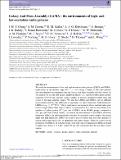Galaxy And Mass Assembly (GAMA) : the environments of high- and low- excitation radio galaxies
Abstract
We study the environments of low- and high-excitation radio galaxies (LERGs and HERGs, respectively) in the redshift range 0.01 < z < 0.4, using a sample of 399 radio galaxies and environmental measurements from the Galaxy And Mass Assembly (GAMA) survey. In our analysis we use the fifth nearest neighbour density (Σ5) and the GAMA galaxy groups catalogue (G3Cv6) and construct control samples of galaxies matched in stellar mass and colour to the radio-detected sample. We find that LERGs and HERGs exist in different environments and that this difference is dependent on radio luminosity. High-luminosity LERGs (LNVSS ≳ 1024 W Hz−1) lie in much denser environments than a matched radio-quiet control sample (about three times as dense, as measured by Σ5), and are more likely to be members of galaxy groups (82^+5_−7per cent of LERGs are in GAMA groups, compared to 58^+3_−3per cent of the control sample.). In contrast, the environments of the HERGs and lower luminosity LERGs are indistinguishable from that of a matched control sample. Our results imply that high-luminosity LERGs lie in more massive haloes than non-radio galaxies of similar stellar mass and colour, in agreement with earlier studies. When we control for the preference of LERGs to be found in groups, both high- and low-luminosity LERGs are found in higher-mass haloes (∼0.2 dex; at least 97 per cent significant) than the non-radio control sample.
Citation
Ching , J H Y , Croom , S M , Sadler , E M , Robotham , A S G , Brough , S , Baldry , I K , Bland-Hawthorn , J , Colless , M , Driver , S P , Holwerda , B W , Hopkins , A M , Jarvis , M J , Johnston , H M , Kelvin , L S , Liske , J , Loveday , J , Norberg , P , Pracy , M B , Steele , O , Thomas , D & Wang , L 2017 , ' Galaxy And Mass Assembly (GAMA) : the environments of high- and low- excitation radio galaxies ' , Monthly Notices of the Royal Astronomical Society , vol. 469 , no. 4 , pp. 4584-4599 . https://doi.org/10.1093/mnras/stx1173
Publication
Monthly Notices of the Royal Astronomical Society
Status
Peer reviewed
ISSN
0035-8711Type
Journal article
Collections
Items in the St Andrews Research Repository are protected by copyright, with all rights reserved, unless otherwise indicated.

